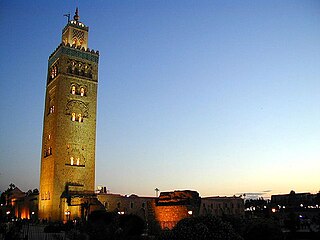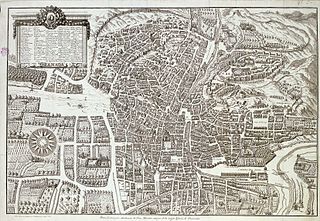
Agadir is a major city in Morocco. It is located on the shore of the Atlantic Ocean near the foot of the Atlas Mountains, just north of the point where the Souss River flows into the ocean and 509 kilometres (316 mi) south of Casablanca. Agadir is the capital of the Agadir Ida-U-Tanan Prefecture and of the Souss-Massa economic region. The majority of its inhabitants speak Amazigh language, one of the two official languages of Morocco. It was the locale for the Agadir Crisis of 1911 between France and Germany that presaged the First World War.

The Saadi dynasty or Saadian dynasty was an Arab Moroccan dynasty, which ruled Morocco from 1549 to 1659.

Ahmad al-Mansur was Sultan of the Saadi dynasty from 1578 to his death in 1603, the sixth and most famous of all rulers of the Saadis. Ahmad al-Mansur was an important figure in both Europe and Africa in the sixteenth century; his powerful army and strategic location made him an important power player in the late Renaissance period. He has been described as "a man of profound Islamic learning, a lover of books, calligraphy and mathematics, as well as a connoisseur of mystical texts and a lover of scholarly discussions."

The Wattasid dynasty was a ruling dynasty of Morocco. Like the Marinid dynasty, its rulers were of Zenata Berber descent. The two families were related, and the Marinids recruited many viziers from the Wattasids. These viziers assumed the powers of the Sultans, seizing control of the Marinid dynasty's realm when the last Marinid, Abu Muhammad Abd al-Haqq, who had massacred many of the Wattasids in 1459, was murdered during a popular revolt in Fez in 1465.

Abū 'Abdullah Muḥammad ibn Sulaymān ibn Abū Bakr al-Jazūli al-Simlālī, often known as Imam al-Jazuli or Sheikh Jazuli, was a Moroccan Sufi leader of the Berber tribe of the Jazulah. He is best known for compiling the Dala'il al-Khayrat, an extremely popular Muslim prayer book. This book is usually divided into 7 sections for each day of the week. Al-Jazuli is one of the seven saints of Marrakesh and is buried in his mausoleum inside the city.

Moulay Idriss or Moulay Idriss Zerhoun is a town in northern Morocco, spread over two hills at the base of Mount Zerhoun. It is famous for being the site of the tomb of Idris I, the first major Islamic ruler of Morocco, after whom the town is named. It is located near Meknes and overlooks the ruins of Volubilis a few kilometers away.

The Draa is Morocco's longest river, at 1,100 kilometres (680 mi). It is formed by the confluence of the Dadès River and Imini River. It flows from the High Atlas mountains, initially south-eastward to Tagounite, and from Tagounite mostly westwards to its mouth in the Atlantic Ocean somewhat north of Tan-Tan. In 1971, the (El) Mansour Eddahabi dam was constructed to service the regional capital of Ouarzazate and to regulate the flow of the Draa. Most of the year the part of the Draa after Tagounite falls dry.

Abdallah al-Ghalib Billah was the second Saadian sultan of Morocco. He succeeded his father Mohammed ash-Sheikh as Sultan of Morocco.
Abu Abdallah al-Qaim bi Amrillah of Tagmadert in the Draa River valley, a claimed descendant of Fatimah, was the ancestor of the Saadi Dynasty of Morocco, who ruled the Sous in Southern Morocco from 1509 to 1517. The Sharifian movement on which the Saadi Dynasty was to be built began when Abu Abdallah, during a visit to Medina, dreamed of two lions entering a tower with a crowd of people close behind. Taking his vision to a Sufi sheikh, he was told that his two sons would have an important future in his country. Upon returning to Morocco he began to broadcast the vision among his people, who believed him, according to Moroccan historian al-Nasiri, because of his reputation for honesty, and he adopted the Mahdist title "al-Qaim bi Amrillah".

Mawlay Mohammed Al-Sheikh Al-Sharif Al-Hassani Al-Drawi Al-Tagmaderti known as Mohammed Al-Sheikh was the first sultan of the Saadi dynasty of Morocco (1544–57). "Al-Drawi at-Tagmadert" means: the man from the Draa river valley, from Tagmadert. He was particularly successful in expelling the Portuguese from most of their bases in Morocco. He also eliminated the Wattasids and resisted the Ottomans, thereby establishing a complete rule over Morocco.

Ahmad al-Araj was a member of the Saadi Dynasty, son of Abu Abdallah al-Qaim bi Amrillah and brother of his successor Mawlay Mohammed ash-Sheikh ash Sharif al-Hassani al-Drawi at-Tagmadert, the first Saadi sultan of Morocco.
Sidi Abderrahman el Majdoub, also transcribed as Mejdub, full name al-Shaykh Abu Zayd Abderrahman al-Majdoub Ibn Ayyad Ibn Yaacub Ibn Salama Ibn Khashan al-Sanhaji al-Dukkali, was a Moroccan poet, Sufi and mystic. He was born into a Berber family. Many lines of his poems are known throughout the Maghreb, and his work is the source of many proverbs.

Notable landmarks of city of Marrakesh, Morocco.

Luis del Marmol Carvajal was a Spanish chronicler living many years among the formerly Moorish Granada kingdom morisco's inhabitants and in the North African Berber regions at the end of the 15th, and a good part of the 16th century.

Turkey–Morocco relations covers relations between Morocco and Turkey, and spanned a period of several centuries, from the early 16th century when the Ottoman Empire neighbored Morocco and until the modern times.

The Battle of Tadla occurred in September 1554 in Tadla, Morocco, between Ali Abu Hassun, last ruler of the Wattasid dynasty, and Mohammed ash-Sheikh, ruler of the Saadis.

The Principality of Debdou was an autonomous hereditary viceroyalty that existed in eastern Morocco from 1430 to 1563, with its capital at Debdou. It was governed by the Ouartajin, a dynasty of Berber descent, related to the Marinids and the Wattasids.

Borj Nord or Burj al-Shamal, Al-Burj ash-Shamali is a fort in the city of Fez, Morocco. It was first established in 1582 by the Saadi dynasty, modeled after the Portuguese forts in the 16th century. It is among the largest defense structures around the city of Fez and one of the few to incorporate European-style changes in military architecture in the gunpowder age. Today, the fort is open to public as the Museum of Arms.

The Zawiya of Sidi Muhammad Ben Sliman al-Jazuli is an Islamic religious complex (zawiya) in Marrakesh, Morocco. It is centered around the tomb of the 15th-century Muslim scholar and Sufi saint Muhammad al-Jazuli, who is one of the Seven Saints of Marrakesh.

The Seven Saints of Marrakesh or Patron Saints of Marrakesh are seven historical Muslim figures buried in Marrakesh, Morocco. Each of them was a famous Muslim judge, scholar or Sufi saint (wali) venerated for their piety or other mystical attributes. Their tombs form the basis of a centuries-old annual pilgrimage, a ziyara, during which visitors pray at each of their tombs over the course of seven days.















